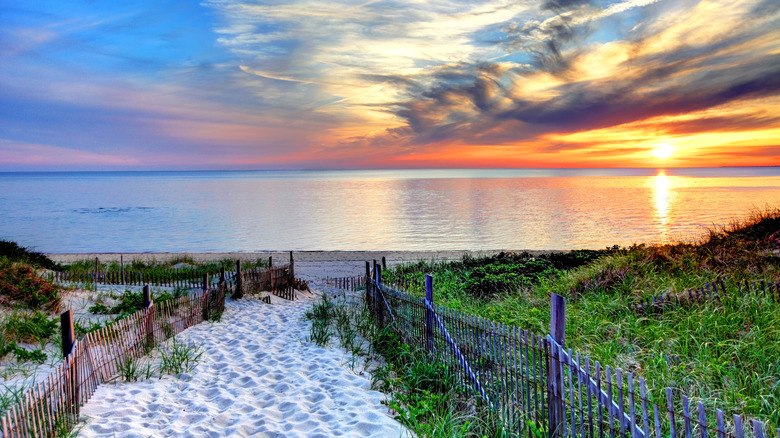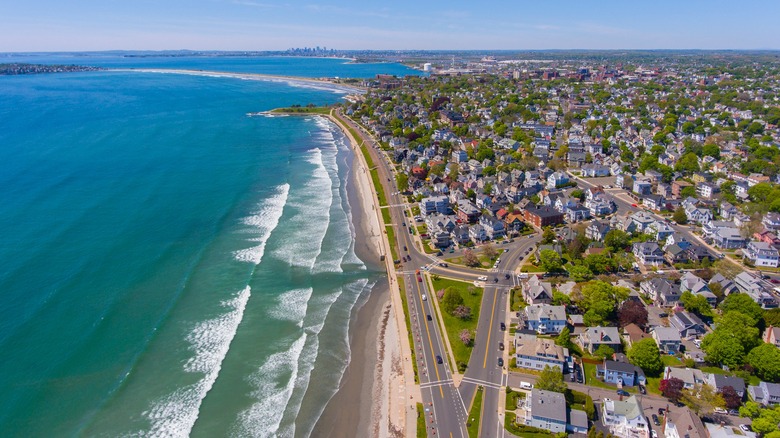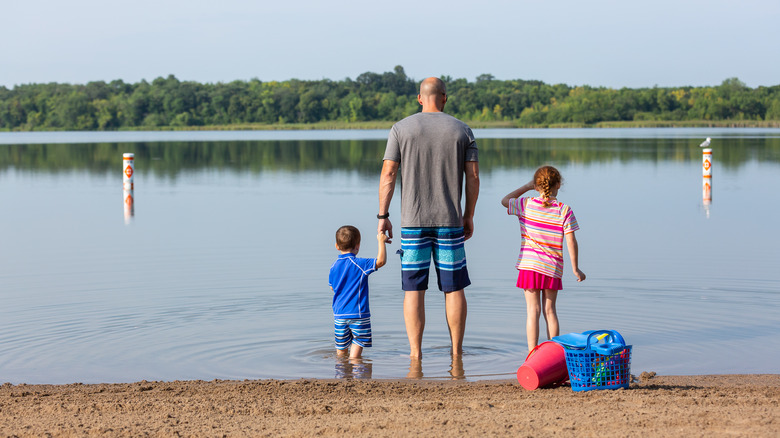The Disgusting Reason Dozens Of Massachusetts Beaches Are Closed To The Public
In the summer, it can be hard to avoid the big crowds at Cape Cod and other Massachusetts beach destinations. However, you might find some popular spots mostly empty this year — though not for positive reasons. Dozens of the state's beaches are closed to the public due to dangerously high levels of bacteria. In most cases, E. coli is the culprit, according to the Massachusetts Department of Public Health, though in rare instances, cyanobacteria bloom is behind the closures.
Coastal beaches aren't the only ones affected by the bacteria — some lake and pond beaches have also been deemed dangerous by officials. In either case, the causes of the bacteria are often the same, according to John Rumpler, the clean water director for Environment Massachusetts. Rumpler told CBS News that the two main causes of excessive bacteria in the water are runoff pollution and overflowing sewage, both of which can be exacerbated by heavy rain.
If your Massachusetts vacation or New England road trip takes you to a beach that has been impacted, play it safe and avoid taking a dip in the water. While you can still relax on the sand, going for a swim could result in nausea, vomiting, diarrhea, skin rash, fever, eye and ear irritation, and other symptoms. Children, the elderly, and immunocompromised individuals are most at risk of serious symptoms, according to the Department of Public Health.
Which beaches to avoid in Massachusetts
Beaches from Boston to western Massachusetts have been subject to closures this summer, including popular destinations such as Hopkinton Reservoir and a portion of summer camping spot, Children's Island. At the time of writing, over two dozen beaches are closed to bathers. In Boston, Tenean Beach was found to have excessive bacteria, as has Smith Beach a little further south. On the Cape Cod peninsula, Clipper Lane and John's Pond have also been impacted, the former by excessive bacteria and the latter by harmful cyanobacteria bloom.
Away from the Atlantic Coast are several other swimming points off-limits to visitors. Berry Pond Beach, Waushakum Beach, and Dunn Pond are just a few that are closed for the time being. While the closures can put a damper on your vacation, the good news is that the majority of Massachusetts' 1,100 public and semi-public beaches are still considered safe for swimmers. Note that the state doesn't perform tests on private beaches, so if you visit a lake, pond, or coastal point not accessible to the general public, it's a good idea to perform your own water quality test (or ask the owner of the area to do so) before going for a swim.
How to find safe beaches
To stay safe at the beach in and out of the water this summer, look out for any flags and signs posted before kicking off your flip-flops and jumping in. Massachusetts beaches closed due to bacteria and other dangers should have clear signs warning swimmers not to enter. You should also check the Department of Public Health's Water Quality Dashboard, which provides up-to-date information on water safety reports and closures. The dashboard is updated twice daily, so check the page often when planning a beach day.
It's usually unclear when closed waters will reopen, though you should expect an impacted beach to remain off-limits for at least a day or two. Once a test shows high levels of bacteria in the water, additional lab tests must be conducted to determine when the water is safe to enter again. This can take at least 24 hours, according to the Department of Public Health.
Besides checking official water safety data, be on the lookout for signs of bacteria-infested waters when at the beach. Water that smells bad, looks especially murky, or appears discolored might not be safe for swimming. When in doubt, stay out of the water to avoid getting sick.


